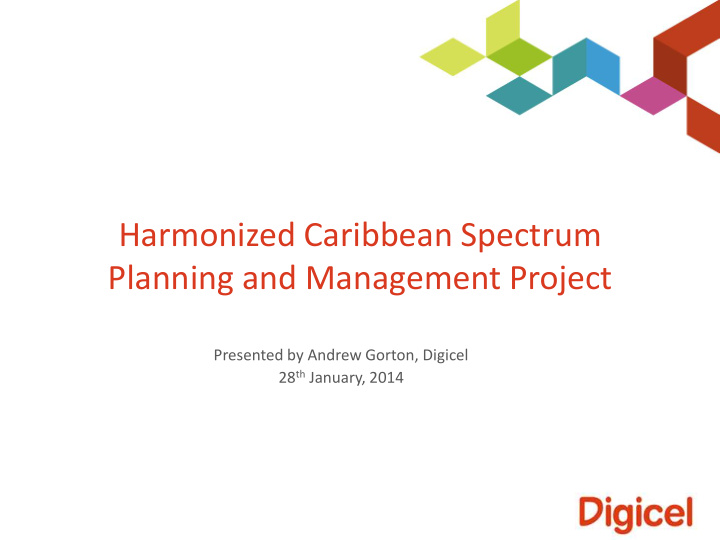



Harmonized Caribbean Spectrum Planning and Management Project Presented by Andrew Gorton, Digicel 28 th January, 2014
Background • The digital switchover process was seen by the IDB and a number of national jurisdictions as an opportunity to address the issue of spectrum for mobile services more widely including harmonisation, policies and pricing. • The IDB is the main sponsor of this project. • Channeled Through CTU
Objective • The objective of the Project is stated as being: “to deepen the harmonization of spectrum planning and management policies and practices across the Caribbean Region, including in areas such as white spaces and frequency reutilization .”
Activities Activity 1 – Reconstitution of governing bodies • Reconstitution of the Caribbean Spectrum Management Steering Committee and Task Force. Activity 2 – Design of mechanisms to provide sustainability to the governing bodies • Development of a study on possible funding mechanisms aiming at the sustainability of the governing bodies. • Assess public and private funding solutions as well as possible public- private partnerships. Activity 3 – Frequency band analysis • Assessment and evaluation of current national frequency band plans.
Activities Activity 4 – Development of a harmonized regional spectrum management plan • Comprises the development of: (i) a framework to minimize cross border interference between beneficiary countries; (ii) harmonized technical and policy approaches for the digital switchover; (iii) a proposal for white spaces management and regulation; and (iv) an assessment of common pricing principles and methods for determining pricing values. Activity 5 – Frequency band proposal • Development of the National Frequency Allocation Table (NFAT) for each country. • Development of a Regional Frequency Allocation Table (RFAT) for the Caribbean. • Facilitate the adoption of common frequencies and relevant international protocols for disaster management and emergency communications.
Expected Results of the Study 1. Beneficiary countries should be able to increase harmonization of spectrum planning and improve management policies and practices. 2. The regulatory and procedural changes should result in cost reductions for mobile broadband services, thereby promoting the population’s adoption and usage of broadband and the Region’s advancement in the digital economy.
Total Cost of the Project The estimated cost of the Project is US$1,088,000, in accordance with the following budget: Local Counterpart Activity/Component Description Bank Total (in-kind) Reconstitution of Spectrum Management Activity 1 Steering Committee and Task Force Steering 100,000 10,000 110,000 Committee Activity 2 Study on possible funding mechanisms 20,000 10,000 30,000 Activity 3 and 5 Harmonized RFAT for the Caribbean 240,000 16,000 256,000 Activity 4 Regional Spectrum Strategic Plan 400,000 10,000 430,000 Activities 1, 2, 3, 4 & 5 Travel (consultants) 30,000 - 30,000 Activities 1, 2, 3, 4 & 5 Regional workshops 110,000 10,000 120,000 Activities 3, 4 & 5 Editing and printing 10,000 2,000 12,000 Activities 1, 2, 3, 4 & 5 Program Manager, Administrative support & 90,000 30,000 100,000 External Audit and Final Evaluation Activities 1, 2, 3, 4 & 5 Total 1,000,000 88,000 1,088,000
Eligible for Funding from the IDB and Compete Caribbean • Barbados • Bahamas • Belize • Dominican Republic • Guyana • Haiti • Jamaica • Suriname • Trinidad and Tobago
Eligible for Funding from Compete Caribbean Only • Antigua and Barbuda • Dominica • Grenada • St Lucia • St Kitts and Nevis • St Vincent and the Grenadines • Compete Caribbean is jointly funded by the Inter-American Development Bank (IDB), the United Kingdom Department for International Development (DFID) and the Foreign Affairs, Trade and Development Canada (DFATD). • Not clear at this time what contribution Compete Caribbean might make.
Proposed Organisation 1. Spectrum Management Steering Committee (5) – Government Policy Makers and Senior Regulators 2. Task Force (14) – Government Policy Makers, Regulators, Operators, Academics, Developers, Researchers 3. Resource Persons 4. CTU to facilitate
Project Completion Date • Project to be completed by 22 Jan 2015.
Use of the Results The results of the project will be used to inform: 1. spectrum planning across the Region; and, 2. input by the Region in to the ITU’s Nov 2015 World Radiocommunications Conference and consequent ITU Regulations and Recommendations affecting spectrum usage.
GSMA View on Candidate Bands for Mobile Broadband • 470 to 698 MHz • 1350 to 1525 MHz (excluding 1400 to 1427MHz which is passive) • 2.7 to 2.9 GHz • 3.4 – 4.2 GHz
Thank you for listening!
Recommend
More recommend